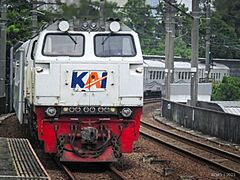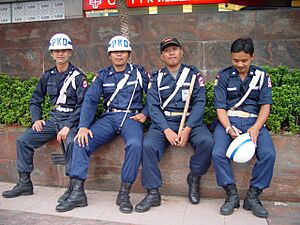Kereta Api Indonesia facts for kids

Logo used since 28 September 2020
|
|
|
Formerly
|
Indonesian State Railways (DKARI/DKA/PNKA/PJKA) (1945–1990) Indonesian Railway Public Corporation (Perumka) (1990–1995) |
|---|---|
| State-owned perseroan terbatas | |
| Traded as | IDX: KAII (bonds) |
| Headquarters |
,
Indonesia
|
|
Key people
|
Said Aqil Siradj (chairman of the advisory board) Didiek Hartantyo (CEO) |
| Owner | Government of Indonesia |
|
Number of employees
|
27,396 (2017) |
| Subsidiaries | KAI Commuter KAI Bandara KAI Logistik KAI Wisata KAI Properti KAI Services |
 |
|

Map of active railway lines in Java as of 2019
|
|
 |
|
| Overview | |
|---|---|
| Fleet size |
List
420 locomotives
578 electric multiple units (by KCI) 121 diesel multiple units 1,607 passenger coaches 6,782 freight cars |
| Headquarters | Bandung, Indonesia |
| Locale | Java, Sumatra (Aceh, North Sumatra, West Sumatra, South Sumatra, and Lampung), Sulawesi (South Sulawesi) |
| Dates of operation | 1945–present |
| Predecessor | See: List of railway companies in the Dutch East Indies |
| Technical | |
| Track gauge | 1,067 mm (3 ft 6 in) (Most of railway lines) 1,435 mm (4 ft 8 1⁄2 in) (Aceh, Sulawesi, LRT Jabodebek) |
| Previous gauge | 750 mm (2 ft 5 1⁄2 in) (Aceh tramway gauge) 600 mm (1 ft 11 5⁄8 in) (tramway gauge) |
| Electrification | 1500 V DC overhead wiring for KCI operation 750 V DC third rail for Palembang LRT, and Jabodebek LRT operation |
| Length | 5,042 kilometres (3,133 mi) |
| Highest elevation | 1,246 m (4,088 ft) (Cikajang railway station) |
PT Kereta Api Indonesia (Persero), often called PT KAI or just KAI, is Indonesia's main railway company. It is owned by the government. KAI runs trains for both people and goods across the country. Its main office is in Bandung, West Java. In 2019, KAI helped 429 million passengers travel and moved 47.2 million tonnes of cargo.
History of Indonesian Railways
KAI has a long history, starting from the time Indonesia was a Dutch colony. The first railway company in Indonesia was called Nederlandsch-Indische Spoorweg Maatschappij (NIS). It started on August 27, 1863.
The first train line opened in 1867. It connected Batavia (now Jakarta) to Buitenzorg (now Bogor). Another line went from Semarang to Vorstenlanden (Surakarta and Yogyakarta). These early companies sometimes struggled. So, the colonial government started its own railway company, Staatsspoorwegen, in 1875.
There was also a private company called Deli Spoorweg Maatschappij. It operated only in North Sumatra. This company mainly transported rubber and tobacco.
In 1939, Indonesia had about 4,588 kilometers (2,851 miles) of railway tracks.
Railways After Independence
After Indonesia became independent in 1945, the different railway systems were combined. In 1953, they became Djawatan Kereta Api Republik Indonesia (DKARI). Later, in 1958, all railway lines were taken over by the government. This included the Deli Railway Company. The new company was named Perusahaan Negara Kereta Api (PNKA) in 1960.
The name changed again in 1970 to Perusahaan Jawatan Kereta Api (PJKA). Many smaller branch lines built during the colonial era were closed down in the 1980s.
In 1990, PJKA became Perusahaan Umum Kereta Api (Perumka). Then, in 1999, it changed into a joint-stock company called PT Kereta Api (Persero). Finally, in May 2010, it became PT Kereta Api Indonesia (Persero), or PT KAI.
Modern Railway Developments
Electric trains were not very common until the 1970s. Since 1976, new electric multiple units (EMUs) have been brought in. These are used for Jabotabek commuter services. This commuter service later became a separate company in 2008.
In 2011, KAI started testing cargo trains. They also signed agreements with big train companies like Bombardier Transportation and GE Transportation. These agreements help build and maintain trains in Indonesia. Indonesian workers do all the local services.
KAI has also worked to restore old railway sites. In 2012, they spent money to fix up 20 historical railway places on Java and Sumatra.
Many busy lines in Java have been made into double tracks. This means there are two tracks instead of one. This helps trains run more smoothly and carry more passengers. For example, a 1,000 km (621 mi) double tracking project on the south coast was finished by 2015.
The first part of the Trans-Sulawesi Railway was finished in 2017. This new line has wider tracks. This allows for heavier and faster trains.
Railway Assets
KAI owns a lot of land and other important assets. These include bridges and signal systems. The company keeps track of its assets to make sure everything runs well.
Railway Tracks
KAI uses two main types of track widths, called gauges. Most lines in Java and Sumatra use a cape gauge (1,067 mm). Some newer lines, like in Aceh and the Trans-Sulawesi Railway, use a wider standard gauge (1,435 mm). This wider track can handle heavier and faster trains. In the past, KAI also used even narrower tracks for trams.
The total length of railway tracks in Indonesia is about 5,042 km (3,133 mi) as of 2019. Many of the busiest lines now have double tracks. This helps more trains run at the same time.
There are also plans to build a railway around Bali. This would be about 565 kilometers (351 miles) long.
Trains and Rolling Stock
As of 2016, KAI operated many different types of trains:
- 420 locomotives (the engines that pull trains)
- 578 electric multiple units (EMUs, electric trains that can run on their own)
- 121 diesel multiple units (DMUs, diesel trains that can run on their own)
- 1,607 passenger coaches (cars for people to ride in)
- 6,782 freight cars (cars for carrying goods)
KAI often buys its trains from a local Indonesian company called PT Industri Kereta Api. This company makes passenger coaches, freight wagons, and electric multiple units.
Locomotives
Most of KAI's diesel-electric locomotives come from the United States or Canada. The diesel-hydraulic locomotives are mostly from Germany. Electric units are usually built in Japan. Indonesia's own industry can also build both diesel and electric trains.
All KAI locomotives (except old steam locomotives) use diesel engines. Newer ones use diesel-electric power. Older ones and shunting trains use hydraulic power.
Locomotives have special names using letters and numbers. These names tell you about the train's wheels, its type, when it started working, and its unique number.
- CC 206 13 31: This means it's the 7th type of diesel-electric locomotive with a Co'Co' wheel setup. It started service in 2013 and is number 31.
- BB 304 84 07R: This is the 5th type of diesel-hydraulic locomotive with a B'B' wheel setup. It started service in 1984, is number 07, and has been rebuilt.
Passenger Trains
KAI runs different classes of passenger trains on Java. These include:
- Executive class (first class)
- Business class (second class)
- Economy class (third class)
Special Carriages
KAI also has "exclusive carriages" or kereta wisata (tourist carriages). These are luxury cars that people can rent and attach to a regular train. They are used by groups like families, companies, or tourists. These carriages offer snacks, meals, and drinks. Some even have a queen bed!
In 2014, KAI launched the Jayabaya train. This train has special carriages for people with disabilities. These carriages have accessible toilets, wider doors, and more space. KAI plans to add these features to other trains too.
Freight Trains
KAI operates trains that carry goods. For example, they transport coal from South Sumatra to Lampung. From there, the coal is shipped to Java.
They also move intermodal containers. Trains can carry many more containers at once than trucks. A train can carry 40 large containers in one trip!
Library Train
KAI has a special "library train" called Kereta Pustaka Indonesia. This train travels to different stations. It holds exhibitions about the company's history and has books for people to read.
Train Maintenance and Depots
KAI has workshops where trains are repaired and maintained. The main workshop for diesel trains in Java is in Pengok, Yogyakarta. In Sumatra, there are workshops in Lahat, Padang, and Pulubrayan.
Other workshops in Jakarta, Tegal, and Surabaya maintain passenger carriages and freight wagons. There are also many places called "motive power depots" where trains are stored and get basic maintenance.
Old, unused electric trains are sometimes taken apart at a large area near Purwakarta station.
Safety and Security
Polsuska is KAI's special police unit for railways. Their job is to keep railway stations and train users safe. They prevent crime and make sure rules are followed. Polsuska officers wear black uniforms and orange hats. They are trained by the Indonesian National Police.
The commuter lines in Greater Jakarta have their own security team called Petugas Keamanan Dalam (PKD). They wear dark blue uniforms and white helmets. They are like security guards.
Every railway station also has security guards who help Polsuska. During busy times, like holidays, members of the armed forces and police might also help with security.
KAI's Subsidiary Companies
KAI has several smaller companies that help with different parts of the railway business.
- PT Pusaka Nusantara: This company helps with restoration, cleaning, and other services for train facilities.
- Reska Multi Usaha: This company provides services like food and drinks on trains, cleaning, and managing restaurants at stations (like the LoKo chain).
- Kereta Commuter Indonesia (KCI): This company runs the electric commuter train services in the Jakarta metropolitan area (like KRL Commuterline).
- Kereta Api Pariwisata (KA Wisata): This company offers special rail tourism services.
- KA Properti Manajemen (KAPM): This company manages KAI's properties.
- Kereta Api Logistik (Kalog): This company handles logistics and cargo transport.
- Railink: This is a joint company with another firm. It operates airport train services, like the Kualanamu Airport Rail Link.
KAI is also part of a group of companies working on the Jakarta–Bandung high-speed train project. This project is operated by Kereta Cepat Indonesia China (KCIC).
- Logos of KAI's subsidiary companies as of September 28, 2020
See also
- KA Commuter Jabodetabek
- Polsuska
- Rail transport in Indonesia











